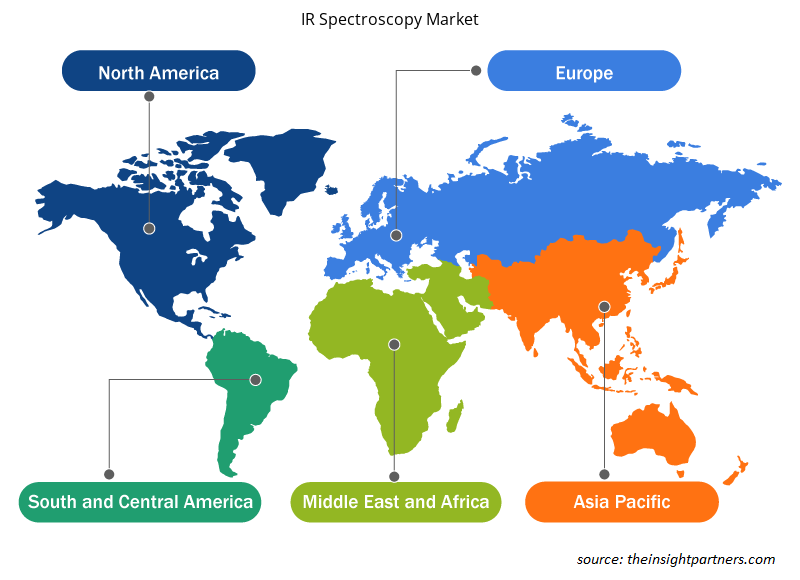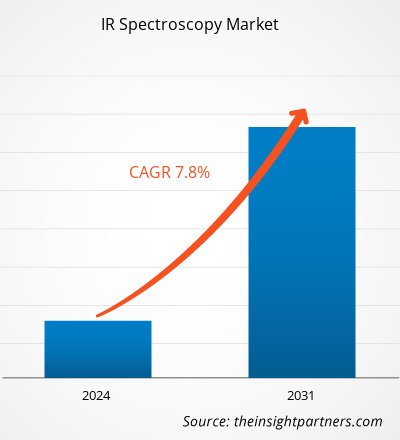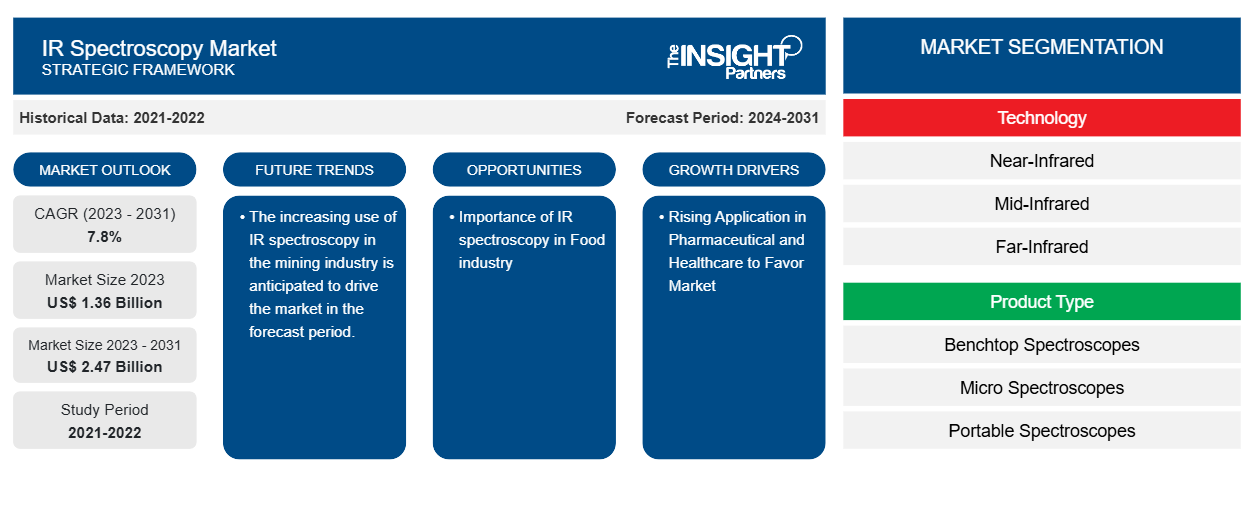Si prevede che la dimensione del mercato della spettroscopia IR raggiungerà i 2,47 miliardi di dollari entro il 2031, passando dagli 1,36 miliardi di dollari del 2023. Si prevede che il mercato registrerà un CAGR del 7,8% nel periodo 2023-2031. Le crescenti applicazioni nei settori farmaceutico e sanitario e la crescita emergente nel settore alimentare rimarranno probabilmente tendenze e driver chiave nel mercato.CAGR of 7.8% during 2023–2031. Increasing applications in the pharmaceutical and healthcare industries and emerging growth in the food industry are likely to remain key trends and drivers in the market.
Analisi di mercato della spettroscopia IR
Si prevede che la domanda per il mercato della spettroscopia IR crescerà con il crescente numero di strutture mediche e centri di ricerca clinica in tutto il mondo. Inoltre, la crescente applicazione nel settore farmaceutico e sanitario e la crescente attenzione della spettroscopia IR nelle economie emergenti. Inoltre, si prevede che il mercato crescerà con l'ascesa del settore alimentare.centres across the world. Also, the rising application in the pharmaceutical and healthcare industry and growing focus of IR spectroscopy in emerging economies. Moreover, the market is anticipated to grow with the rise in the food industry.
Panoramica del mercato della spettroscopia IR
La spettroscopia infrarossa (spettroscopia IR) è la spettroscopia che si occupa della regione infrarossa dello spettro elettromagnetico, ovvero la luce con una lunghezza d'onda maggiore e una frequenza inferiore rispetto alla luce visibile. Copre una gamma di tecniche, per lo più basate sulla spettroscopia di assorbimento. Come tutte le tecniche spettroscopiche, può essere utilizzata per identificare e studiare le sostanze chimiche.
Personalizza questo report in base alle tue esigenze
Riceverai la personalizzazione gratuita di qualsiasi report, comprese parti di questo report, o analisi a livello nazionale, pacchetto dati Excel, oltre a usufruire di grandi offerte e sconti per start-up e università
-
Scopri le principali tendenze di mercato in questo rapporto.Questo campione GRATUITO includerà analisi di dati che spaziano dalle tendenze di mercato alle stime e alle previsioni.
Driver e opportunità del mercato della spettroscopia IR
Crescente applicazione nel settore farmaceutico e sanitario per favorire il mercato
Le persone anziane del mondo hanno attualmente vari deficit psichiatrici e neurologici . Inoltre, le funzioni cerebrali di questi pazienti sono profondamente compromesse, limitando così la loro indipendenza nella vita quotidiana. In questi casi, la spettroscopia IR è molto essenziale. Inoltre, la spettroscopia nel vicino infrarosso è utilizzata nella sintesi e purificazione di API (principi attivi farmaceutici) e fermentazioni biofarmaceutiche. La tecnologia è ideale perché è stata progettata per analizzare miscele complesse.
Importanza della spettroscopia IR nell'industria alimentare.
Negli ultimi anni, il metodo della spettroscopia infrarossa per l'analisi degli alimenti si è sviluppato in modo significativo. La spettroscopia infrarossa può essere utilizzata per condurre un'analisi della qualità su diverse famiglie di gruppi alimentari come carne, frutta, pesce, verdura, latticini, uova e cereali. Poiché la tecnica della spettroscopia infrarossa si è sviluppata e si è evoluta nella sua applicazione nell'analisi degli alimenti, è infine diventata uno strumento affidabile e potente. Il metodo ha vari vantaggi che lo rendono lo strumento analitico appropriato per molti gruppi alimentari e aziende alimentari.
Analisi della segmentazione del rapporto di mercato sulla spettroscopia IR
I segmenti chiave che hanno contribuito alla derivazione dell'analisi di mercato della spettroscopia IR sono la tecnologia, il tipo di prodotto e l'utente finale.
- In base alla tecnologia, il mercato della spettroscopia IR è suddiviso in vicino infrarosso, medio infrarosso e lontano infrarosso. Si prevede che il segmento vicino infrarosso detenga una quota di mercato significativa nel periodo di previsione.
- In base al tipo di prodotto, il mercato della spettroscopia IR è suddiviso in spettroscopi da banco , microspettroscopi, spettroscopi portatili e spettroscopi con trattino. Si prevede che il segmento degli spettroscopi da banco detenga una quota di mercato significativa nel periodo di previsione.
- In base all'utente finale, il mercato è segmentato in sanità, prodotti chimici, petrolio e gas, alimenti e bevande e altri utenti finali. Si prevede che il segmento sanitario detenga una quota di mercato significativa nel periodo di previsione.
Analisi della quota di mercato della spettroscopia IR per area geografica
L'ambito geografico del rapporto di mercato sulla spettroscopia IR è suddiviso principalmente in cinque regioni: Nord America, Asia Pacifico, Europa, Medio Oriente e Africa, Sud e Centro America.
Il Nord America ha dominato il mercato. Il mercato della spettroscopia IR sta crescendo in Nord America a causa della robusta crescita della domanda di spettroscopia IR in vari settori come sanità, prodotti farmaceutici, prodotti chimici e alimenti e bevande. Inoltre, la forte enfasi sulla ricerca e sviluppo sta rendendo la regione tecnologicamente avanzata. Inoltre, il Nord America comprende un gran numero di produttori di spettroscopia IR. Pertanto, a causa dei parametri di cui sopra, il mercato della spettroscopia IR sta crescendo in Nord America.
Approfondimenti regionali sul mercato della spettroscopia IR
Le tendenze regionali e i fattori che influenzano il mercato della spettroscopia IR durante il periodo di previsione sono stati ampiamente spiegati dagli analisti di Insight Partners. Questa sezione discute anche i segmenti e la geografia del mercato della spettroscopia IR in Nord America, Europa, Asia Pacifico, Medio Oriente e Africa e America meridionale e centrale.

- Ottieni i dati specifici regionali per il mercato della spettroscopia IR
Ambito del rapporto di mercato sulla spettroscopia IR
| Attributo del report | Dettagli |
|---|---|
| Dimensioni del mercato nel 2023 | 1,36 miliardi di dollari USA |
| Dimensioni del mercato entro il 2031 | 2,47 miliardi di dollari USA |
| CAGR globale (2023-2031) | 7,8% |
| Dati storici | 2021-2022 |
| Periodo di previsione | 2024-2031 |
| Segmenti coperti |
Per tecnologia
|
| Regioni e Paesi coperti |
America del Nord
|
| Leader di mercato e profili aziendali chiave |
|
Densità degli attori del mercato: comprendere il suo impatto sulle dinamiche aziendali
Il mercato della spettroscopia IR sta crescendo rapidamente, spinto dalla crescente domanda degli utenti finali dovuta a fattori quali l'evoluzione delle preferenze dei consumatori, i progressi tecnologici e una maggiore consapevolezza dei vantaggi del prodotto. Con l'aumento della domanda, le aziende stanno ampliando le loro offerte, innovando per soddisfare le esigenze dei consumatori e capitalizzando sulle tendenze emergenti, il che alimenta ulteriormente la crescita del mercato.
La densità degli operatori di mercato si riferisce alla distribuzione di aziende o società che operano in un particolare mercato o settore. Indica quanti concorrenti (operatori di mercato) sono presenti in un dato spazio di mercato in relazione alle sue dimensioni o al valore di mercato totale.
Le principali aziende che operano nel mercato della spettroscopia IR sono:
- Tecnologie Agilent
- Inc.
- Società Bruker
- Hitachi
- Società anonima
- Azienda HORIBA LTD
Disclaimer : le aziende elencate sopra non sono classificate secondo un ordine particolare.

- Ottieni una panoramica dei principali attori del mercato della spettroscopia IR
Notizie di mercato e sviluppi recenti sulla spettroscopia IR
Il mercato della spettroscopia IR viene valutato raccogliendo dati qualitativi e quantitativi post-ricerca primaria e secondaria, che includono importanti pubblicazioni aziendali, dati di associazioni e database. Di seguito sono elencati alcuni degli sviluppi nel mercato della spettroscopia IR:
- Wiley, uno dei più grandi editori al mondo e leader globale nella ricerca e nell'apprendimento, ha annunciato il rilascio del nuovo Wiley Database of Predicted IR Spectra. Il database combina oltre 60 anni di esperienza nella spettroscopia infrarossa (IR) e nella cura dei dati spettrali con le più attuali tecniche di apprendimento automatico per espandere significativamente il numero di dati spettrali IR disponibili per l'analisi spettrale. (Fonte: Wiley, sito Web aziendale, novembre 2023)
- Edinburgh Instruments ha annunciato il lancio del suo nuovo spettrometro FTIR da banco, l'IR5, progettato e prodotto presso la sede centrale globale in Scozia. L'IR5 è il primo spettrometro a infrarossi a trasformata di Fourier (FTIR) del marchio Edinburgh Instruments, rinomato per la sua competenza nella strumentazione per spettroscopie di assorbimento Raman, fluorescenza e UV-Vis. (Fonte: Edinburgh Instruments, sito Web aziendale, marzo 2023)
Copertura e risultati del rapporto di mercato sulla spettroscopia IR
Il rapporto "Dimensioni e previsioni del mercato della spettroscopia IR (2021-2031)" fornisce un'analisi dettagliata del mercato che copre le seguenti aree:
- Dimensioni e previsioni del mercato della spettroscopia IR a livello globale, regionale e nazionale per tutti i principali segmenti di mercato trattati nell'ambito dell'indagine.
- Tendenze del mercato della spettroscopia IR e dinamiche di mercato, quali fattori trainanti, limitazioni e opportunità chiave.
- Analisi dettagliata delle cinque forze PEST/Porter e SWOT.
- Analisi di mercato della spettroscopia IR che copre le principali tendenze del mercato, il quadro globale e regionale, i principali attori, le normative e i recenti sviluppi del mercato.
- Analisi del panorama industriale e della concorrenza che comprende la concentrazione del mercato, l'analisi delle mappe di calore, i principali attori e gli sviluppi recenti per il mercato della spettroscopia IR.
- Profili aziendali dettagliati.
- Analisi storica (2 anni), anno base, previsione (7 anni) con CAGR
- Analisi PEST e SWOT
- Valore/volume delle dimensioni del mercato - Globale, Regionale, Nazionale
- Industria e panorama competitivo
- Set di dati Excel
Report recenti
Testimonianze
Motivo dell'acquisto
- Processo decisionale informato
- Comprensione delle dinamiche di mercato
- Analisi competitiva
- Analisi dei clienti
- Previsioni di mercato
- Mitigazione del rischio
- Pianificazione strategica
- Giustificazione degli investimenti
- Identificazione dei mercati emergenti
- Miglioramento delle strategie di marketing
- Aumento dell'efficienza operativa
- Allineamento alle tendenze normative























 Ottieni un campione gratuito per - Mercato della spettroscopia IR
Ottieni un campione gratuito per - Mercato della spettroscopia IR